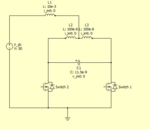fillherin
Newbie level 3
Hi, I am new to power electronics, this a push pull current fed converter.There is some part I do not understand, please help!!!!!

Let's consider there is no series resistance on inductors and capacitors. 1 of the switch is turning on and another one is turning off, both duty cycle is 50% and frequency of 100kHz.
The DC voltage source is 50V.

The red line is the voltage across L1, and Green line is the current of L1,
Question1: WHY THE CURRENT IS NEARLY ZERO? Actually it is around 0.0329 Amps(RMS), How do we calculate the L1 current?
Question2: WHY THE VOLTAGE GOES TO 50V(Maximum) and -30V(Minimum)? Why not -50V?
Thanks in advance!!:lol::lol::lol:

Let's consider there is no series resistance on inductors and capacitors. 1 of the switch is turning on and another one is turning off, both duty cycle is 50% and frequency of 100kHz.
The DC voltage source is 50V.
The red line is the voltage across L1, and Green line is the current of L1,
Question1: WHY THE CURRENT IS NEARLY ZERO? Actually it is around 0.0329 Amps(RMS), How do we calculate the L1 current?
Question2: WHY THE VOLTAGE GOES TO 50V(Maximum) and -30V(Minimum)? Why not -50V?
Thanks in advance!!:lol::lol::lol: